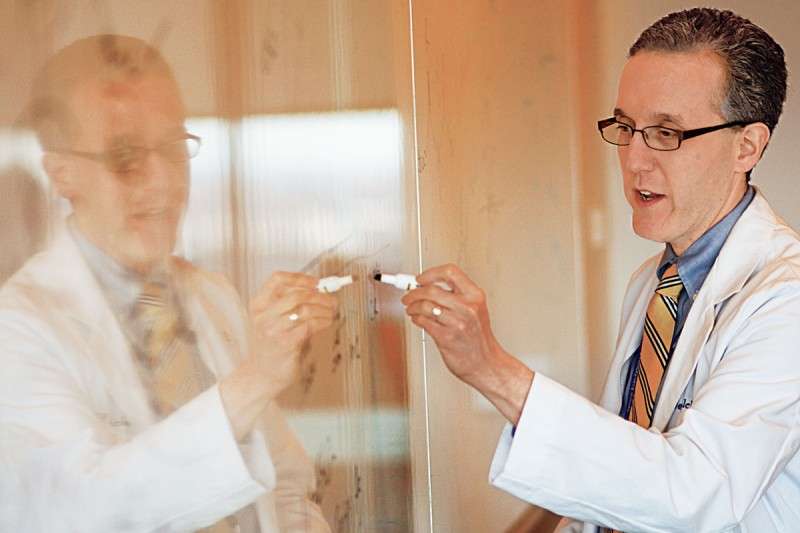Medical oncologist Jedd Wolchok pioneered a combination immunotherapy treatment for patients with advanced melanoma that has just been approved by the FDA.
Today, the US Food and Drug Administration (FDA) approved the immunotherapy combination nivolumab (Opdivo) plus ipilimumab (Yervoy) for use in patients with metastatic melanoma. This is the first-ever combination immunotherapy to receive approval by the FDA. To learn more, we spoke with Memorial Sloan Kettering medical oncologist and cancer immunologist Jedd Wolchok, the physician-scientist leading this work.
Where did the idea to combine nivolumab and ipilimumab come from?
The idea to combine these two immunotherapies emerged after we had strong scientific evidence that each one was effective by itself. We had worked with ipilimumab for several years, but it appeared to benefit only 20 percent of patients. Nivolumab had shown early signs of good activity for newly diagnosed patients, and a similar medicine (pembrolizumab) had activity in disease that was refractory—which means it wasn't responding to treatment— or relapsed after initial treatment with ipilimumab. Then there were lab experiments that showed the two strategies worked well together. So in 2010, before either drug had FDA approval on its own, we embarked on the phase I trial testing the combination of the two. Ultimately the results showed a 53 percent response rate—quite a bit higher than we expected. For some patients, it was very dramatic. We would get scans back showing that virtually all of the disease had gone away.
After the first 15 to 20 people, we began working with our colleagues at Bristol-Myers Squibb to design phase II and then phase III trials. The results of the phase II trial were presented in April during a meeting of the American Association for Cancer Research and published in the New England Journal of Medicine by my colleague Michael Postow, who was a fellow in our group back when we did the phase I trial. This past June, I presented the phase III results at the American Society of Clinical Oncology annual meeting.
So it took five years from start to finish. That's fast!
Yes, to me that's the most exciting thing. We've gone from presenting the initial data to rolling this treatment out for standard use in quite a reasonably short period of time.
What do you attribute this rapid pace to?
A few things. First, we saw an unmistakable signal when using the combination in patients. And these patients had a high unmet need—they didn't have many other treatment options. Then there was exceptional coordination between the FDA, the academic investigators, and our industry colleagues. This example actually shows that drug development doesn't necessarily require enormous studies with many years of follow-up. It's possible to move at a much faster pace when everyone is collaborating effectively.
Can you describe the moment you knew this combination was going to be a success?
By my desk, I have an email pinned up from one of our pathologists dated July 7, 2010. It has the pathology results from one of the very first patients to receive the regimen. This patient had a very large lump on his side, and every time he came in it got smaller and smaller. But after four doses, it wasn't completely going away, and we wondered if the disease was resistant to treatment.
One of our surgeons, Mary Sue Brady, removed the lump, and I was so very eager to know what was going on that I waited outside the operating room while it was being removed. "What did it look like?" I asked her colleague when she came out. "Oh, just metastatic melanoma," she said, and I was so disappointed.
Then, a week later, I got an email with the pathology report.
"Completely necrotic tumor surrounded by immune cells—the histologic picture of treatment success."
In other words, the tumor was dead. I smiled, I printed it out, and it's been hanging on my cork board ever since. And that was our second patient to receive the combination.
As someone who has dedicated his career to improving treatment for people with advanced melanoma, what does this mean for you?
When I joined the MSK faculty in 2000, the median survival for patients with advanced melanoma was seven months with the best treatment available at that time. Now we are routinely hearing about two- and three-year survival. In the last study we did, we were seeing patients with 14 months of progression-free survival—which means they lived with their disease but it didn't grow or spread—and that's just an estimate. It gives you a flavor for how rapidly the expectations for life have changed, and it happened all within the first part of just one person's career.
How has MSK's focus on collaboration and translational research made this advance possible?
MSK has had a tradition of excellence in treating melanoma and in developing novel therapies. Immunotherapy has actually been a focus at MSK since the late 1890s, and we have been a part of all the major immunotherapy advances throughout the history of cancer treatment.
For this particular regimen, we were among the very first to use this novel combination, we designed the pivotal studies that have supported approval, and we've done some of the most important research to understand who benefits and why. We haven't answered all the questions yet, but we look forward to pursuing the answers and understanding how we use this regimen to help even more patients, for example those with lung cancer and other cancer types.
Journal information: New England Journal of Medicine
Provided by Memorial Sloan-Kettering Cancer Center


















